Parallel park
Introduction
At this stage of your training your:-
- P.O.M routine (moving off)
- Steering to a safe driving position and pulling up on the left
- Clutch control
- Co-ordination of foot controls including gear changing up and down
- M.S.M routine at junctions, moving off and stopping
- Adequate clearance around stationary vehicles and slower moving vehicle (cyclists and pedestrians)
- T, Y junctions, crossroads including more complex junctions (traffic lights and roundabouts) and timing of gaps right
should be improving and getting more (independent) client-centred
Agreed lesson is covering :-
Parelle park.
Agree level of instruction on the way to the training location
Intervention
On the drive to the reversing location you will assessed on the skills and drills from all other lesson briefs:-
Agree if any of the lesson is going to be a instructor-lead-lesson or a client-centred-lesson and if it is client-lead agree if the instructor has to intervein verbally, take control of the training vehicle by ether using the dual control or take the wheel the lesson plan may need to be changed until the fault is fixed.
F.I.S.H
- Fault
- Implication
- Solution
- Help
Lesson aims and strategies
The aim of today’s lesson is to incorporate the Look, Asses, Decide and Act and Mirror, Signal, Position, Speed, Gear routine's when driving into a parking space. Previous reversing (straight line reverse ) would of already helped you to develop your clutch control. remember to move the clutch to the biting point then move the clutch pedal a £1 thickness up and down so you keep full control throughout the manoeuvre.

Risk responsibility objective's
On the way to the training location you and your instructor will agree the level off support from your instructor:-
- Full talk through
- Prompt
- Independent.
This is important to ensure that the instructor and student understands who has the main responsibility on the control of the training vehicle on the set lesson plan.
Your level of instruction will be given by your instructor to a level to suit you from full talk through then reducing your support to either prompt or independent.
Please note from November 2017 the DVSA changed the format of the driving test changed, the reversing around corners and the turn in the road exercises has been replace with parking up on the right hand side of the road and reverse back 2 too 3 car length and driving into a parking bay then reverse back out of it.
However you will still be taught learnt the reversing around corners and the turn in the road exercises manoeuvres at a lower structured level from your driving instructor.
Why still teach the turn in the road and reversing around a corner?
Why just think if you are on your driving test and you go the wrong way (like a dead end road) and you was unable to turn your training vehicle around safely.....
The turn in the road exercise will be taught to you at a certain point in your training as all driving instructors alter lesson briefing to suit all students needs, however all lesson briefs are agreed at the end of each lesson lesson, so this will give you the opportunity to read the relevant brief (gestalt).
Back ground
The reverse park exercise is needed skill as there are more vehicles on the road than in the 1970 or even 1990's. So you need to be able to park outside your own home, a busy street or even town areas.
There is never sufficient space to drive forward into a vacant parking space and therefore your only option is to reverse into a space.
The reverse park is about using revere gears and controlling the vehicle as your control your vehicle around and behind someone’s parked vehicle.
Lesson brief
It is more mechanically sound for you to reverse behind a parked vehicle than to drive forward and bounce up the kerb to park in to a space. As when you drive forward you could damage your wheels, steering rack or suspension.
Reverse behind a parked vehicle on the left hand side of the road
You will only be taught to reverse behind a parked vehicle on the left hand side of the road. However if you request to learn how to reverse on the right hand side of the road your driving instructor will be happy to cover the required reference points.
You could be asked to put your wing mirror at the front of the target vehicle or line your (nearside) passengers wing mirror with the targets vehicles (offside) drivers wing mirror,
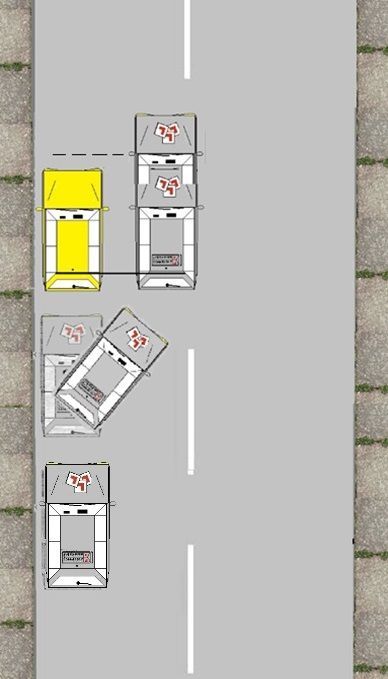
Reverse in a one way or a two way road
On your driving lesson or driving (practical)test you could be asked to do the Parelle park exercise on a one or two way street, so ensure you look for the appropriate road markings and signs.
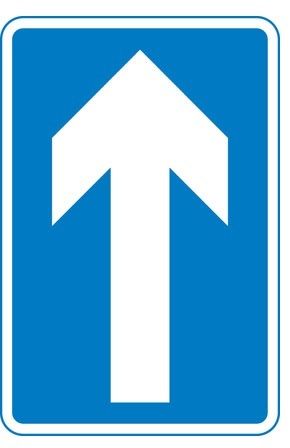
Location.
Once you have got to the training location you will be asked to park up on the left some where safe, legal and convenient on the left hand side of the road.
Once you have parked up you will be asked to drive across the road to start the manoeuvre.
Remember to park up slightly wider (and parallel) from the Kerb.
Make sure you are parked somewhere safe, legal and convenient.
- Park (roughly) a 1ft (drain width) from the kerb.
- Ensure it’s free from parked vehicles, obstructions and no debris on the road as you don’t want to
get a (puncher) flat tyre.
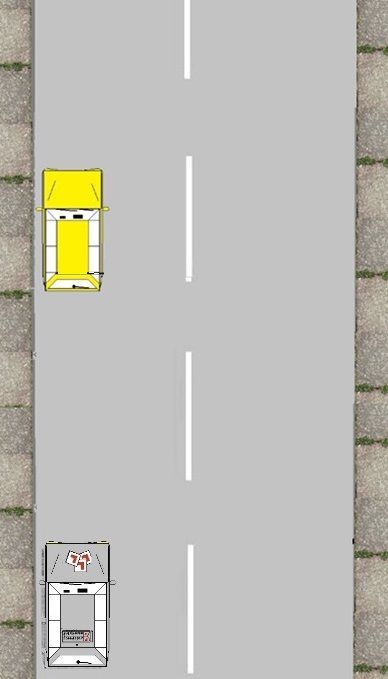
P.O.M
Please note your objective is once you have been briefed on the manoeuvrer is then to progress and drive straight into the bay without stopping and starting.
Prepare
Clutch down, select 1st gear find the biting point

Observations
Normal 6 point check so go from your left shoulder to the right shoulder.

Move
Once you have assessed it is safe to start the manoeuvre (when no vehicles are driving towards you), release your hand brake and pull along side the (yellow) target vehicle.

Pull alongside the target vehicle
In a realistic situation you would park alongside the target vehicle straight away however on a driving practical test you are pulled up on the left hand side of the road first.
Distance from the target vehicle
When it is safe pull up next to the target vehicle about ½ to a door length to it (this will keep a safe distance once you are reversing).
Position
Position your vehicle parallel to the target vehicle so that it will allow sufficient room for oncoming vehicles to pass.
The closer you are to the target car the more difficult it will be to get a suitable angle to reverse into the space available (roughly 1/2 to a 3/4 of a door length).
Risk management
On this reverse manoeuvre you are reversing behind someone's pride and joy, so only attempt to reverse behind it a maximum of 3 times and if you are unsuccessful by the third attempt just drive on and pick another vehicle. Secondly the starting point distance once you pull along side the target vehicle. Be roughly a 1 door length (1 meter) away from it as you do not want your front end of your vehicle to be shaving the back end of it.
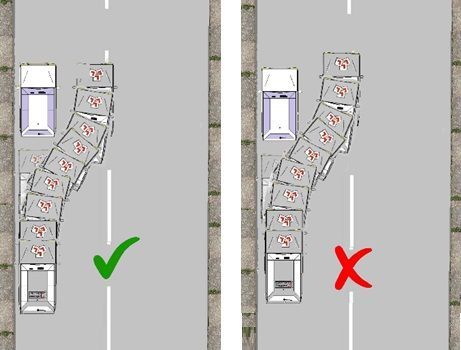
Use of steering
Just like all the other set reverse manoeuvrer's you need to briskly move the steering wheel with accurate clutch control will guarantee success.
Remember quick hands and slow/controlled foot pedals (Fast steering and good clutch control).
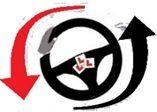
Camber of the road
Most roads do have cambers however it may give you a problem when you are on your last part on this reverse manoeuvre, as you could pick up unnecessary speed because of the decline of the road.
Starting point next to the target vehicle
Ensure your vehicles wing mirror looks like the below picture so your n/s wing mirrors is in front of the target vehicle.

Use of brakes
If any vehicle approach your front end or the rear of your training vehicle indicate your intension and use your brakes to warn the vehicle you have seen them and stopped.

Hand(s) position
When reversing you would usually hold the steering wheel with the right hand at the 12 or 1 o’clock position and the left hand at the 6/7 o’clock position. This will hopefully keep the vehicle to stay in a straight line when you are looking out of your rear window when reversing.
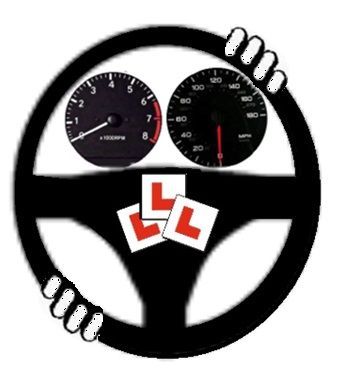
Use of seat belt.
By law you are allowed to remove your seatbelt, however it’s not practical as you could forget to put it back on or if you need to abandon your manoeuvre because a vehicle has come behind you. You will need to put it back on before you drive forward.
Releasing your seatbelt can help, however if you shuffle around in your seat you can look through the rear window by looking over your left shoulder a lot easier.
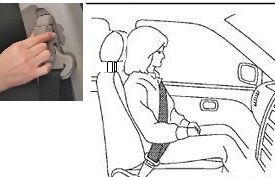
All around observations
Constantly for look around for for any dangers and give way to any approaching vehicles, cyclists and pedestrians on all 4 sides of your training vehicle (that's on your left, right in front and behind you). Not forgetting road users emerging or wanting to leave another parking space.
When reversing who do you give way too?
This could help when to stop when obstacles are coming towards you:-
- Motor vehicle 6 car lengths from you.
- Cycle about 3 cars lengths from you.
- Pedestrians 1.5 car lengths from you.
Reference points (so accurate)
Throughout this manoeuvre you will have different set reference point, each point of turn will will be discussed in this brief and on your lesson.
Now your vehicle is a long side the target vehicle prepare your vehicle to reverse.
Prepare - Clutch down, reverse gear and find the biting point.
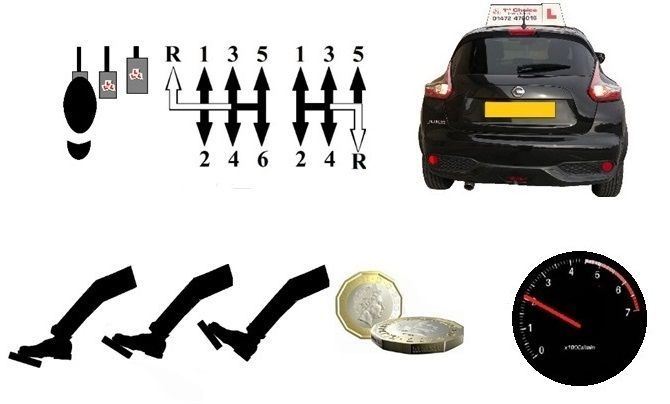
Observations
Reverse the 6 point check so go from your right shoulder to the left shoulder, so you’re looking the correct way (over your left shoulder)

Signal your intentions clearly
Make sure your intentions are known, so once you are alongside the target vehicle by putting your vehicle straight into reverse gear. If a vehicle ever appears and drives towards (or behind) put on a left indicator to back up your intension.
Use your brake lights to also highlight you have seen the vehicle and you have stopped.

Move
When no vehicles are driving towards you (that's both sides of your vehicle) release your handbrake and steer to the left and start to reverse back SLOWLY (crawling pace).

Dealing with other road users
You must always give way and stop to vehicles that approach to the front and rear off you. You will find vehicles are not patient and will pass you even when you have turned your wheel to the left and your front end of your training vehicle is swinging out (when you are trying to achieved the 45 degree angle), some may wait but most of them will still probably drive past you “so always stop and wait”!. As you can see observations is very important in this manoeuvrer.
Pedestrians
You must also give way and allow priority to any pedestrians crossing behind and crossing in front of you.
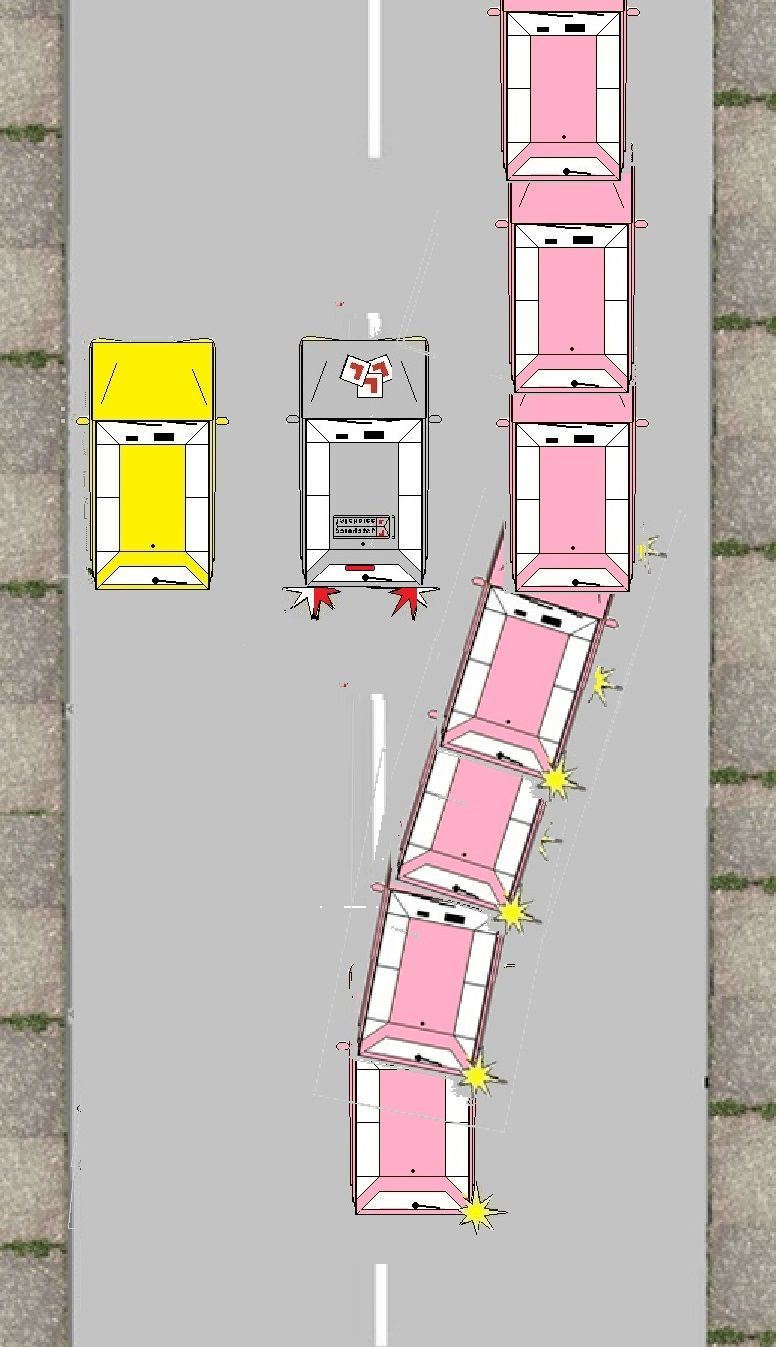
Keeping calm
Other experienced drivers will appreciate that if you rush this manoeuvre you will end up taking longer and run the risk of hitting something or someone.
Therefore if traffic appears once you have started the manoeuvre you will usually find that they give you priority.
Under no circumstances allow yourself to be hurried when doing this exercise.
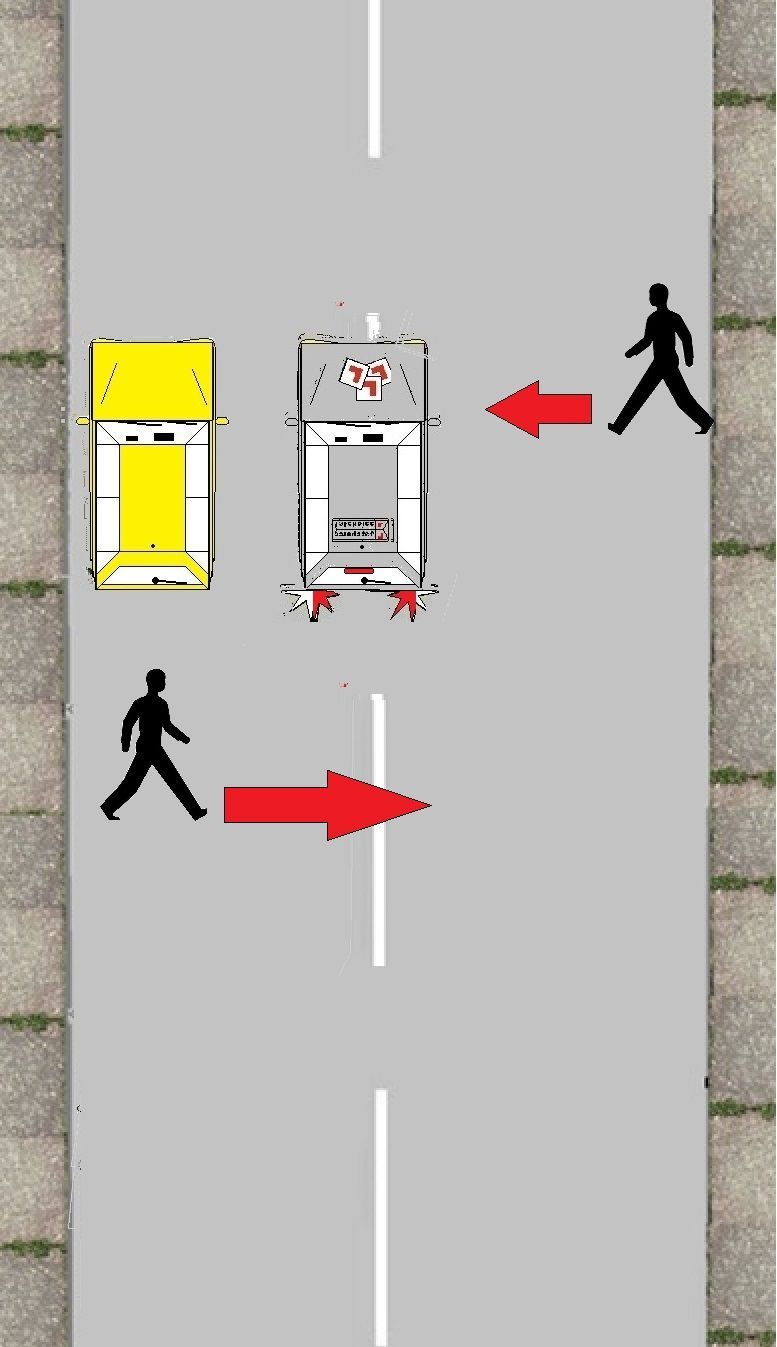
- Could be the wing mirrors together.
- Back wheels together.
- Reference point in the back N/S passenger's window (in picture below)
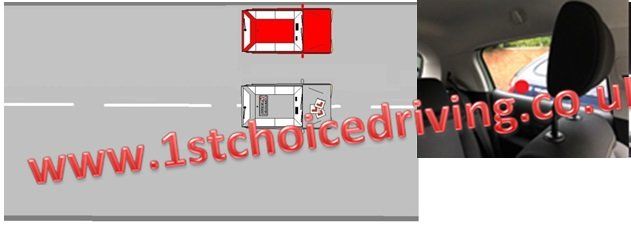

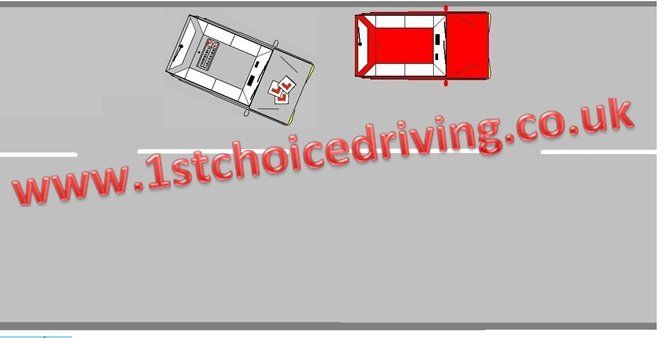
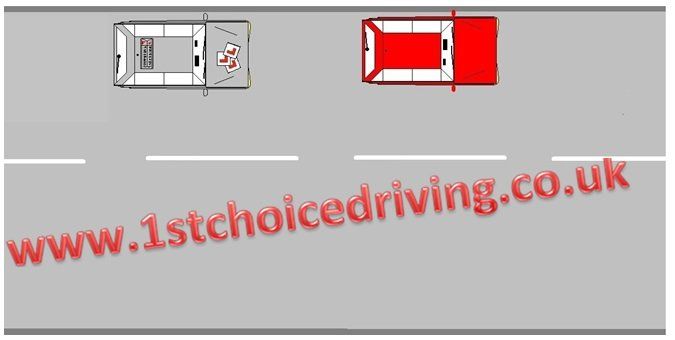
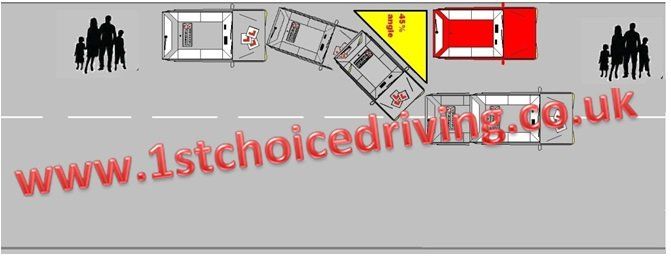
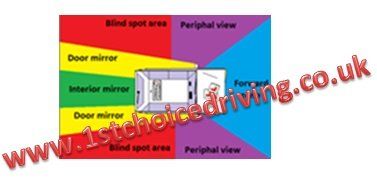
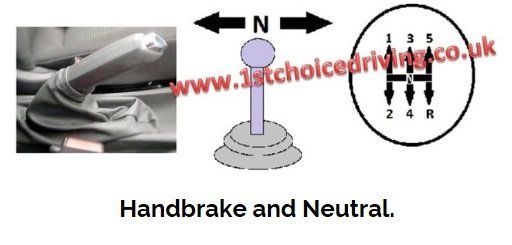
- Fault identification.
- Fault analysis.
- Remedial action.
- Full talk through.
- Prompt.
- Independent.
- Feed back at the end of your lesson.
- Student’s responsibility of lesson and improvements.
- Plan for the next lesson.

